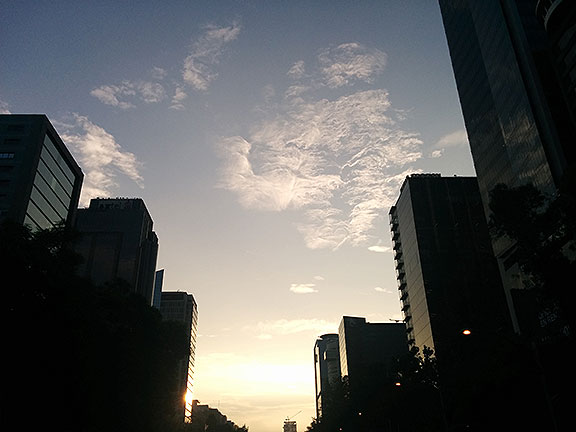
Many mornings I left from the hotel and walked across Paseo de la Reforma just after dawn…
Sitting in the airport getting ready to leave Mexico City after seven weeks here. What a great time! I came to take a Spanish class at the UNAM, actually in the Centro de Enseñanza Para Extranjeros (CEPE) which I highly recommend. I was placed in Básico 4, and I think that was exactly right. I ended up with 93/100 on the final exam, good here for a B+ (shocking to Americans used to our extremely lax grading standards, where anything over 85 gets an A). The grade was of no importance of course, but the test helped me know if I’d gotten anywhere during the 6 weeks of 3 hours per day classes. Apparently yes!
I certainly feel like I can speak and understand much better than earlier, and now the task is to keep it alive and growing at home. I’ll actually have to have some real discipline, dedicating at least an hour a day to reading Spanish language books, newspapers, or websites, as I’ve been doing all summer. And speaking much more when I’m among Spanish speakers, not uncommon in our daily life in San Francisco. Finally I think I’ve put away the horrible shame I was trapped by when it came to speaking another language. We’ll see.
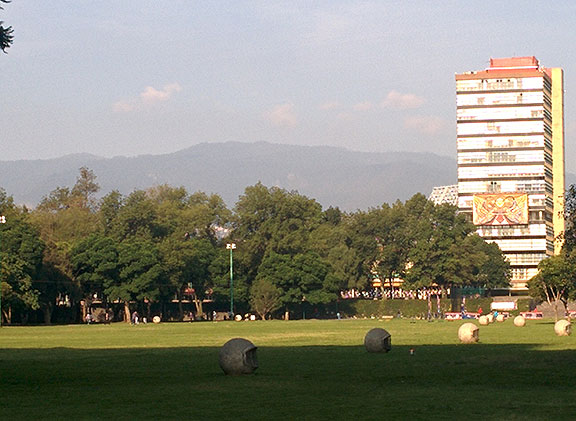
Early morning on the UNAM campus.
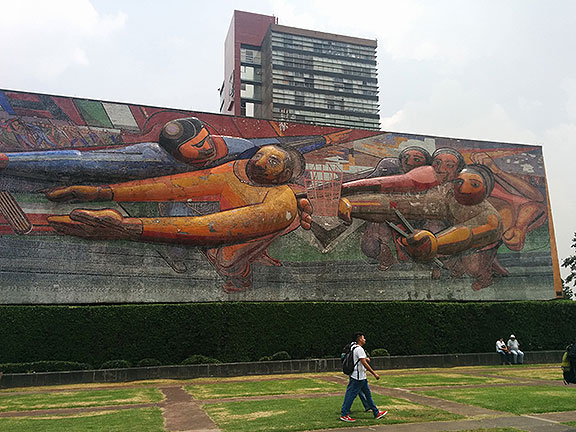
Prominent murals by David Alfaro Siquieros on the campus.
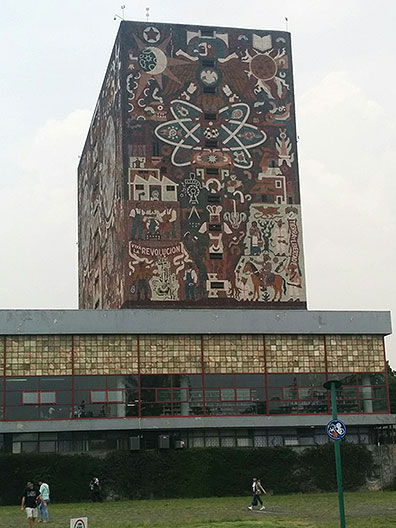
The famous mosaic murals made entirely of natural stone except the blue, which is glass, covering the 1950s UNAM library.
Spending nearly two months in one of the world’s greatest cities has been an incredible thrill apart from the enjoyable success with the language. Mexico City, famous for its horrendous traffic, air quality, and water problems, is still one of my favorite cities. There are so many gorgeous parks, tree-lined boulevards, neighborhoods of all sorts sporting fantastic architecture from many eras, more museums than any other city, and of course the food! The food here is off the hook. You can indulge in fantastic street food practically any time, and the enormous range of restaurants and bars makes every meal a treat, often accompanied by live music. This place is a cultural powerhouse, and it’s so vast that I barely scratched the surface. But I did manage to get to know a few neighborhoods pretty well, and according to my phone app that is monitoring my walks, I walked over 260 miles since July 1!!
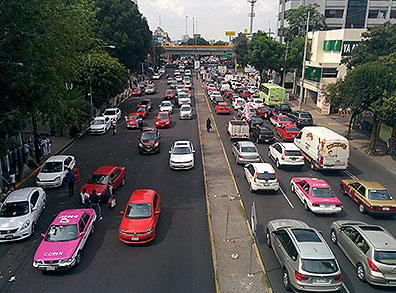
You can’t go anywhere in Mexico City without running into traffic jams and gridlock.
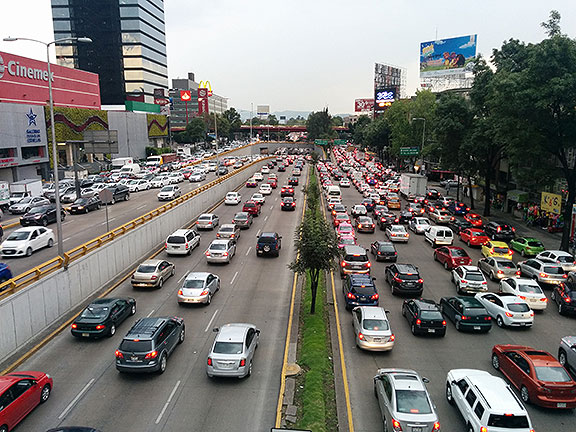
I spent some of my time reading “The Interior Circuit” by Francisco Goldman (this is a photo of it, a circular freeway around the city), first in English and then in Spanish after I left it on the plane!
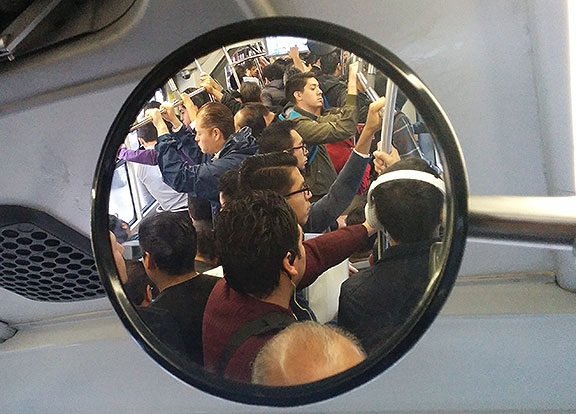
I took this photo inside a morning commute on the Metrobus, shooting into the mirror that looked up towards the front of the articulated vehicle.
Having a daily routine where I had to make my way from the city center to the campus at “Ciudad Universitaria” far to the south was a great way to integrate into daily life here. During one of my last rides crushed in a Metrobus, always amazingly overcrowded just like the underground Metro is too, at least anywhere near commute hours, I found myself feeling this great affection for everyone around me. I suppose that when you are pressed together day in and day out, there’s a certain intimacy and shared tolerance that we all have to cultivate, and it left me feeling a weird kind of love. I don’t know if that happens to folks here but there’s no question that Mexican culture is far more polite and generally indirect than most places. I retained a sense of wonder at my daily experiences, and never really felt close to be a “chilango” (a local Mexico City person), but I did feel that I shared the daily life here for this time, and I loved it.

This tiled roof over a doorway on a decaying apartment building in Santa Maria de Ribera was easy to miss until I took a closer look.
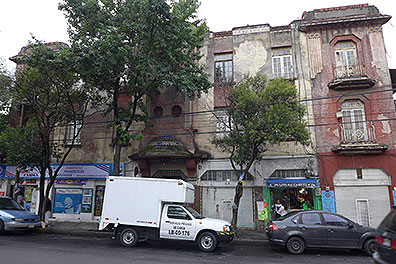
This was the first view of the same architectural gem.
One of the great treats for me was having a daily newspaper I could read with interest and enthusiasm every day. It’s been years since I could do this in the U.S., and really I never had the experience of picking up a daily paper that was chock-full of actual news, mostly national, but some good international coverage too. What was I reading? La Jornada is the daily paper. I also read the weekly magazine Proceso, and there’s a good online journal called horizontal.mx that regularly publishes great historical and topical essays, along with a lot of cultural reporting too.
Through the good journalism of La Jornada I was able to track the remarkable summer-long developments of the teachers fight against a program of neoliberal educational reform. Teachers in the southern states of Oaxaca, Chiapas, Guerrero, and Michoacan, found their allies in other states—even in the north of Mexico in the states of Nuevo Leon and Tamaulipas where historically it has been rare to see movements spread, and Gulf states like Veracruz and Yucatán. Major highway blockades by rank-and-file elementary school teachers, occupations blocking major shopping malls, seizure of train tracks and toll booths, and confrontations with riot police leading to shooting and death in several cases, have dominated the national news in Mexico all summer. Camping in the heart of Mexico City in a “plantón” while riot cops used 12-foot shields to block their access to the Zocalo in the heart of the city, the thousands of teachers infiltrated the plaza anyway, using a strategy they called the “march of the ants.” Some writers have characterized this as an unprecedented movement in Mexican history. Writing in an editorial at the end of July in La Jornada Luis Hernández Navarro said that “far from diminishing, the mobilizations are spreading… The movement has already become a real hurricane. According to the ex-governor of Tlaxcala José Alvarez Lima, ‘we are starting to see in the south of Mexico a real popular revolt.’
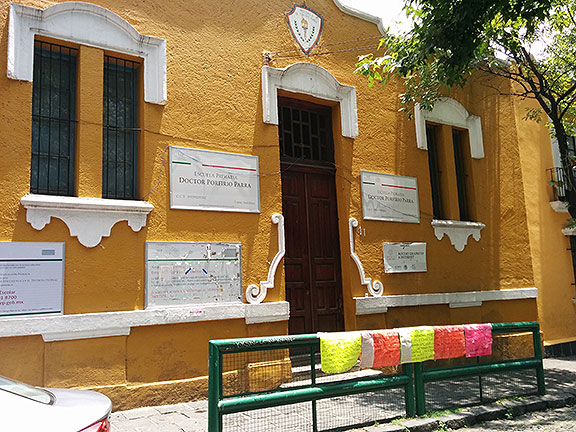
I must’ve seen several dozen local protests, schools with banners and hand-made signs, and similar manifestations, while wandering around Mexico City.

Close-up on the sign on the railing.
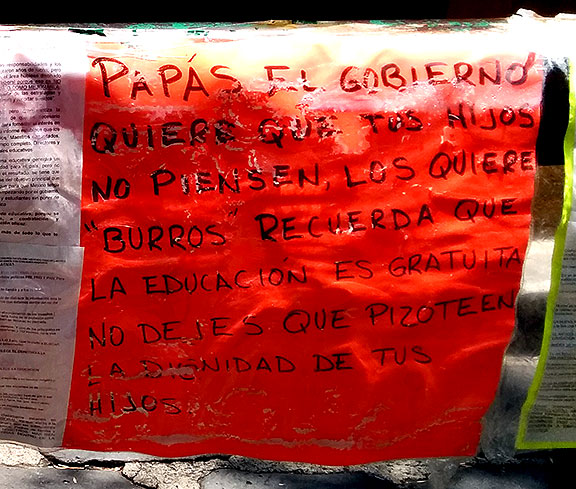
Another sign on the railing.
While this has been going on, other groups have emerged to ally with the teachers, and to append their own struggles and demands to that larger more prominent campaign. Miners facing toxic working conditions and insecure employment in the northwest, people along industrially polluted rivers, students demanding higher enrollments in local public universities, supporters of the 43 disappeared students in Ayotnizapa (that most blame on the government), nearly 100,000 farmworkers and campesinos who converged a week ago in the center of the Capital to press their demands to change how Mexico produces and consumes food and how land is owned and used—all of these and countless below-the-radar efforts are snowballing.
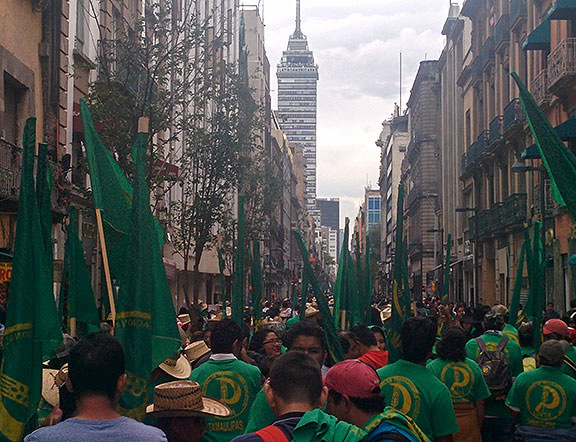
One hundred thousand farmworkers gathered in the center of Mexico City a week ago to demand resources and policy changes from the government.
Can they come together into any kind of coherent alternative to the status quo? The three main political parties are all immersed in internal squabbles, and endless inter-party rivalries, and none are exempt from the endemic corruption and sheer ineptitude of the bureaucracies here. A law passed this summer to give real prosecutorial teeth to anti-corruption efforts, combined with earlier reforms to the criminal justice system, might eventually lead to some meaningful changes. But similar to other countries, there is not really a political vehicle that represents this diverse and dynamic set of social movements that are creatively on the move. There is still some enthusiasm in parts of the left for the personal campaign of AMLO, Andres Manuel Lopez Obrador, the candidate of the center-left PRD who lost (probably through fraud) to the right-wing PAN party’s Felipe Calderon two elections ago in 2007. He has since launched his own party called Morena, though it seems unlikely that a unified left will come together to back him again. A lot of middle-class Mexicans view him with great suspicion, even many on the left see him in the Latin American tradition of the Caudillo, the strong-man who promises to make things right for the working class and the poor (think Hugo Chavez, Juan Perón), but requires hierarchical power and unrelenting loyalty… it’s not a story that ever ends well, notwithstanding the hopeful fantasies it can inspire in some prior to actually wielding power.
Over the past few weeks the main teachers union organizing against the reforms, the CNTE (distinct from the SNTE which has been genuflecting before the education minister and endorsing everything he says) has entered a so-far unproductive dialogue with functionaries of the Education Ministry. The educational reform package, passed by the legislature early in the sexenio (the six-year term of current president Enrique Peña-Nieto—a man who famously couldn’t name a book he’d read when someone asked him at the Guadalajara Book Fair when he was running for office), was probably adapted from right-wing educational reformers in the U.S. The law abrogates teachers’ labor rights, and subjects them to annual testing… beyond the injustice of these specifics, the larger issue, oft-repeated by teachers on the blockades and in demonstrations, is that this so-called reform was put together without any consultation with any actual teachers. They argue that the reform law is actually designed to hand over public education to some large Mexican businesses who are ready to turn schooling into profit-centers—not so different than the neoliberal agenda for education in the U.S.
The teachers went out on strike on May 15 and school is set to resume on August 22. The strikers will have to decide: under heavy pressure from the government, many parents and children, and even parts of the Catholic Church, the teachers could open classes next Monday and keep their fight going from within, or they could hold out and keep schools from opening across half or more of the country. The government has been giving lip service to the dialogues, but continues to insist that A) the reforms are necessary and good and that B) the executive branch cannot change the reforms unless the legislature amends the laws it passed 3 years ago. It’s a very typical process of offering olive branches of negotiation without any actual fruit. In the August 19 paper, the CNTE declared that the strike would continue and school would not open.
Alongside the negotiations, a major summit on education and neoliberalism was held last week where dozens of prominent academics came forward to denounce the government’s project and to back the teachers in their call for a complete abrogation of the reform program in favor of a new round of consultative planning for reforms that the teachers support. No one defends the status quo as being ok. Reforms are urgently demanded by teachers and students too, but very different than what the government is trying to impose. It should be noted too that the teachers came out against the reform program as soon as it was announced. For three years their efforts to halt it and turn it to more constructive ends has been met with silent indifference or militarized repression, including several small massacres. The rising tide of militance this summer was so successful in tying up the major highways of the southern part of the country that the national Chamber of Commerce and various business organizations from southern states all demanded that the government use force to open the roads. One national business group even threatened to withhold tax payments pending the restoration of “order,” in a clearcut case of institutional blackmail. The day after the business sector threats, legislators from all three main parties held a press conference to support the government in pursuing negotiations INSTEAD of the historically common resort to heavy violence. (Still, there have been a number of incidents, most prominently the police shooting that killed 8 in Noxichtlan, Oaxaca on June 19, and a brutal attack on a road blockade in the state of Chiapas by thugs and out-of-uniform cops that fortunately didn’t kill anyone.)
Social conflict! Hundreds of thousands of mobilized teachers, miners, campesinos, and students… Daily press that actually covers the news in complex and nuanced ways! A city full of plazas, parks, cafés, bars, restaurants, and choking on its own traffic, subway and bus-rapid-transit WAY over capacity, and a metropolitan region of over 20 million people! And pyramids! And museums and ruins everywhere, the city sprawled over the old lake, the canals and rivers that once could have been the foundation of a Venice-like paradise instead buried in cement tubes and major boulevards and even freeways built over them. And an active volcano belching tons of volcanic dust on a daily basis! Mexico City has its gentrified neighborhoods, and more are in the works. Towering skyscrapers are being built in several zones to house still more office work and luxury apartments. But in spite of all this, there is a daily life that has its roots in a way of living that is mostly lost to us in the U.S. There are still dense streets full of only electric appliances, or shoes, or fabric stores, or … there is a familiarity to the rhythm of life here, and yes there are more and more smartphones here too, but it doesn’t seem like the whole world has collapsed into a pixel-dominated universe… yet! There are countless establishments that have been in business for decades if not centuries. Neighborhoods that were once stand-alone pueblos far from the City still harbor family dwellings that have been occupied for generations. The rootlessness of our lives compares badly to the deeper history and cultural memory that is embedded in the daily life of this city.
Mexico City. What a place!
Photos the rest of the way…
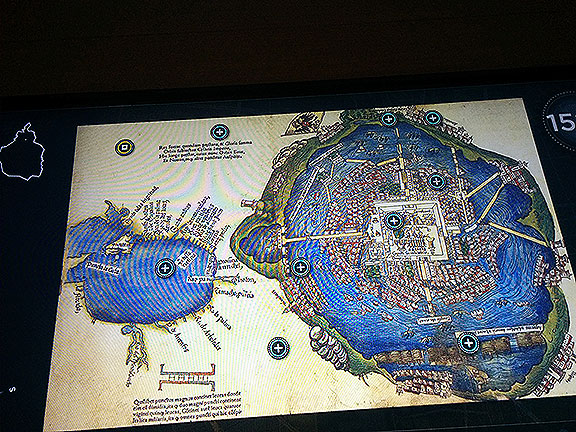
The earliest map of Tenochitlan, the Aztec capital built on the huge lake that once occupied the Valley of Mexico.
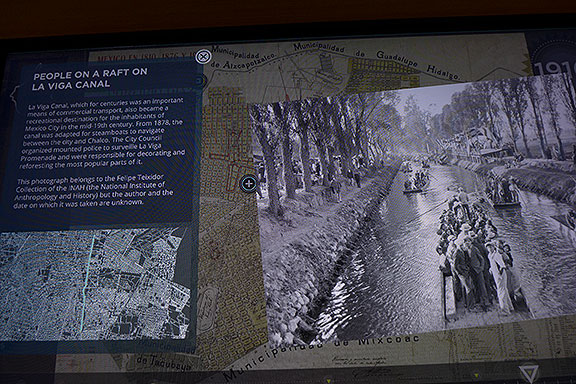
La Viga Canal, that once reached all the way to the center of Mexico City and was used to bring food and flowers into market.
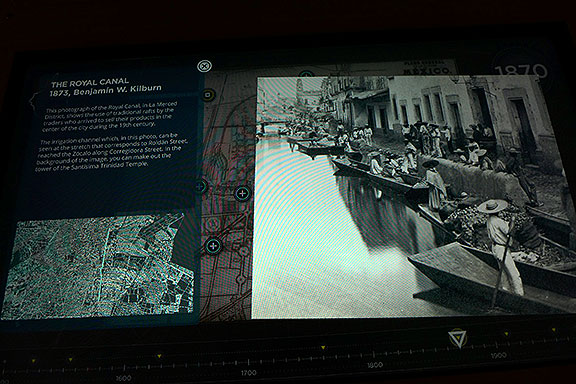
The Royal Canal in 1873, still an important thoroughfare in Mexico at the time.
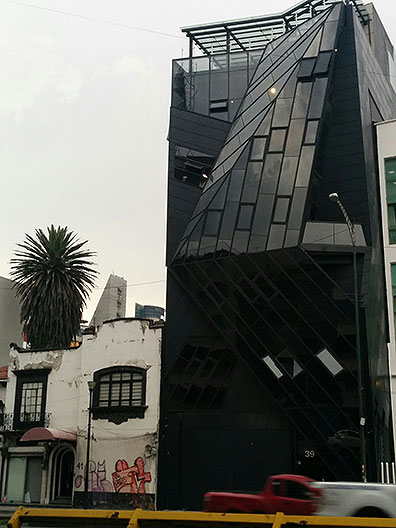
Crazily wonderful juxtapositions of architecture are practically the norm across many parts of Mexico City.
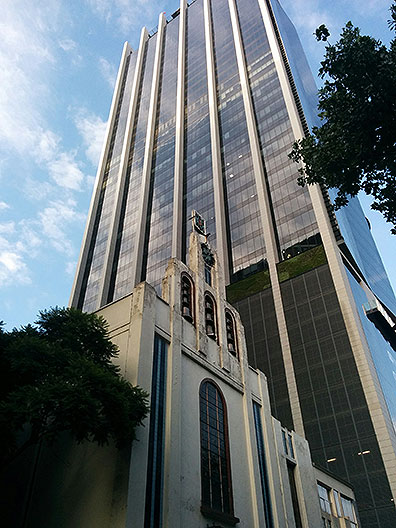
Who is in charge here?
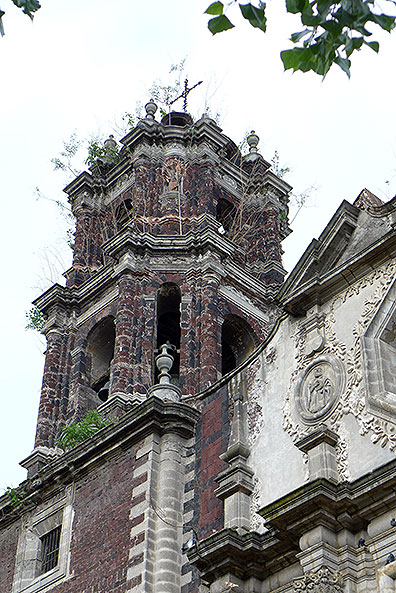
Mexico is a predominantly Catholic country, but many of the churches are in various states of disrepair and delightfully ruined…
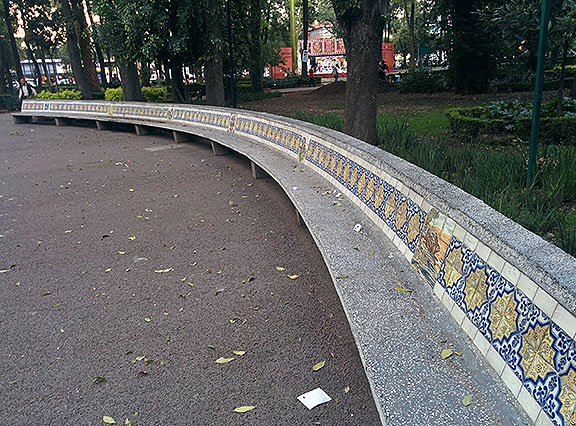
This tiled park bench in Parque Venados caught my eye.
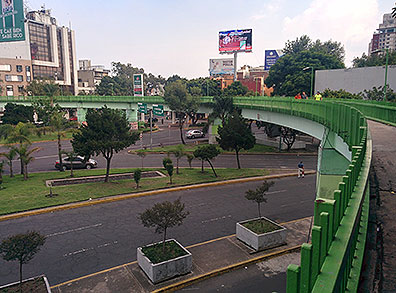
Wandering around in southern neighborhoods I crossed the Division del Norte intersection of several major boulevards on this overpass.
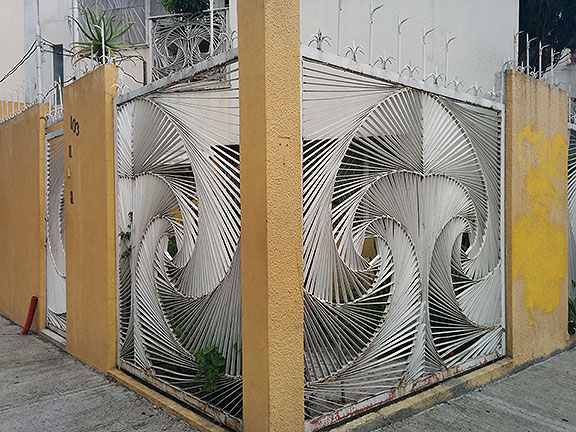
A beautiful fence in Santa Maria de Ribera, one of my favorite neighborhoods.
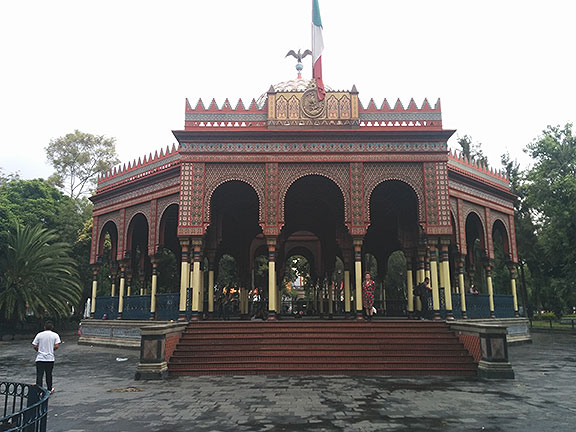
This amazing islamic-inspired gazebo sits in the middle of the Alameda de Santa Maria de Ribera.
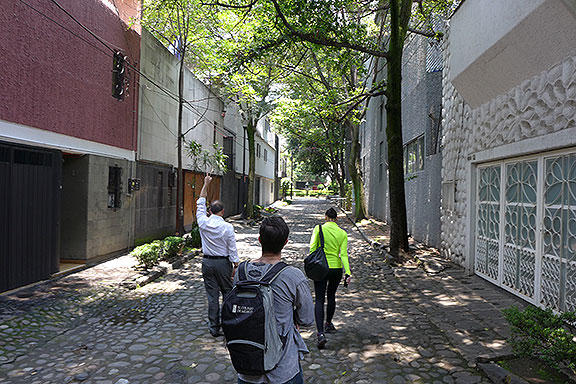
Had a surprising tour from my geography professor through the old pueblo of Chimalistac, practically adjacent to the campus but well hidden by wide boulevards choked with traffic.
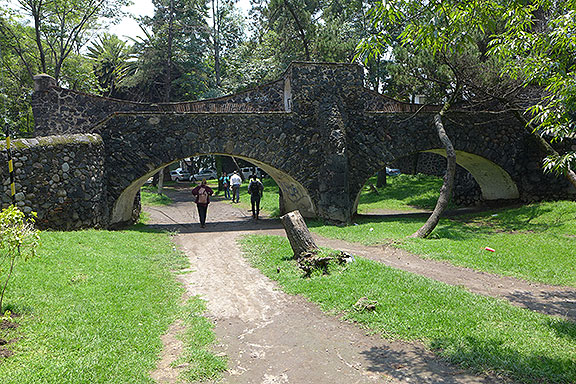
The Paseo del Rio, now a cobble-stoned street alongside this winding park covered by 18th century stone bridges, was once an actual river.
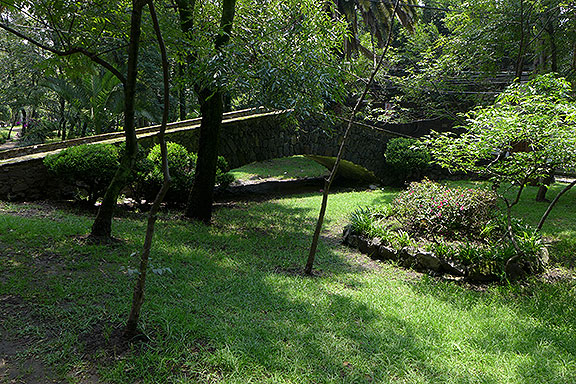
This gorgeous bridge was probably built by a major landowner as a personal bridge to his hacienda.
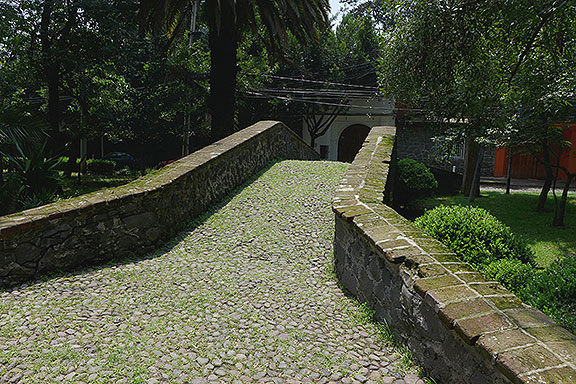
Impressive construction.
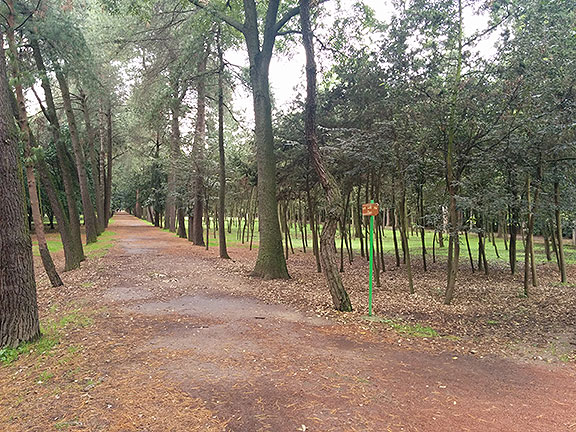
Parque Viveros

Parque Hundido
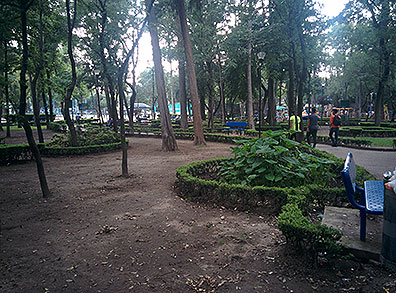
Most of the parks around Mexico City are reminiscent of Parisian parks…
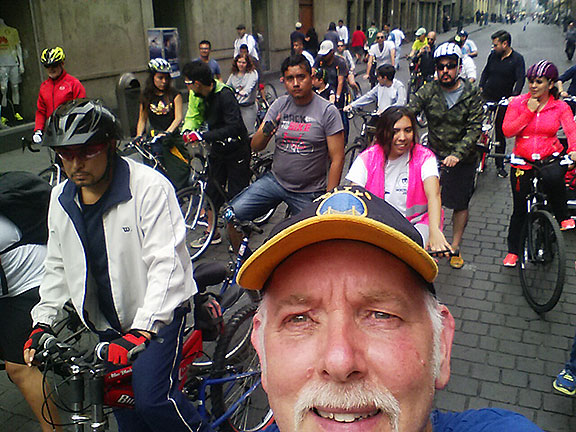
Enjoyed a couple of Sundays riding the closed streets around town.
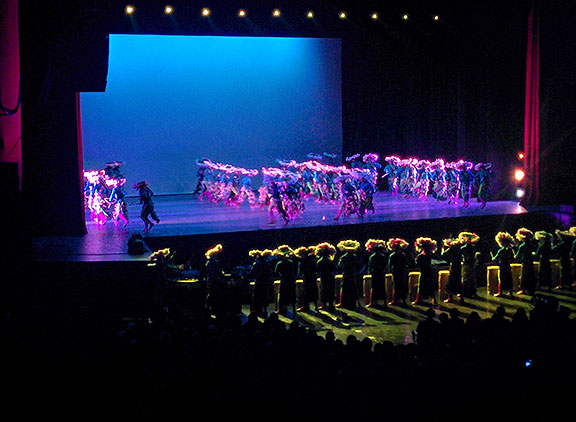
The Ballet Folklorico was absolutely stunning, not to be missed.
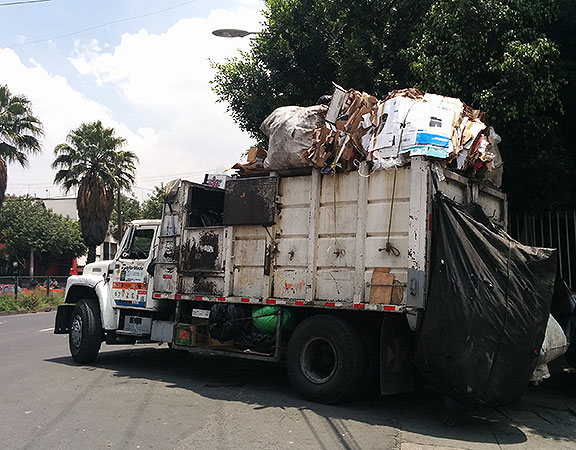
Impossible to understand how the thousands of garbage trucks manage to move the thousands of tons of waste out of the city every day…

On top of the Pyramid of the Sun!
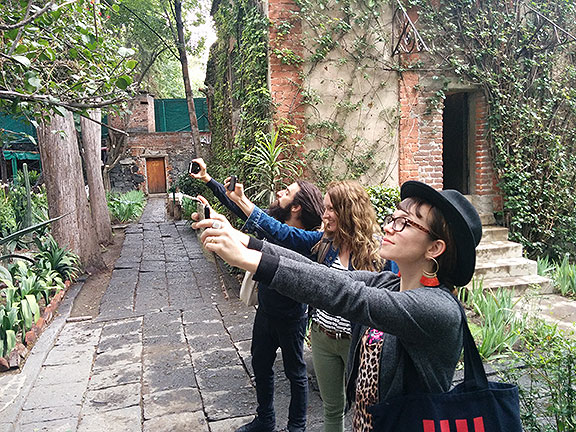
Selfies at Trotsky’s house!
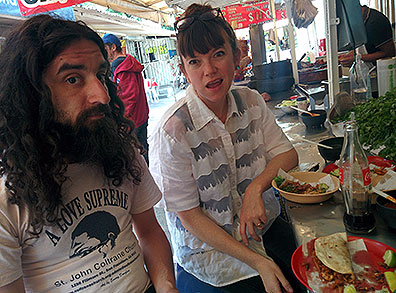
Tacos for lunch!
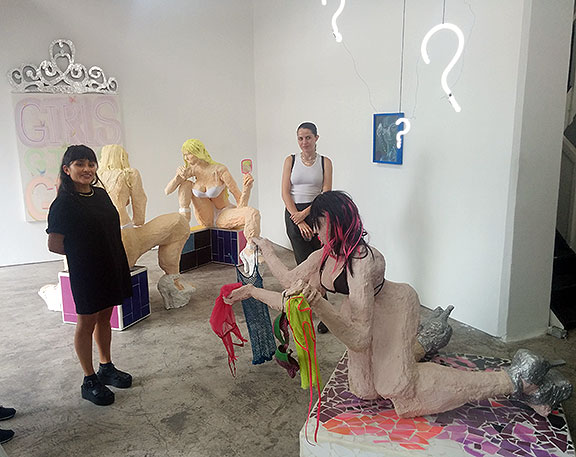
Chelsea Culprit’s art show…
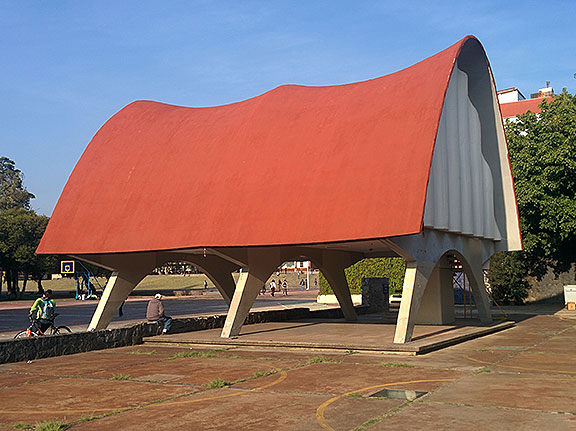
A structure to capture cosmic rays on the UNAM campus!
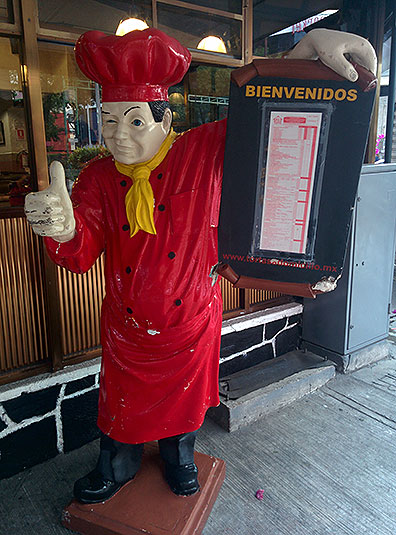
Let’s eat!
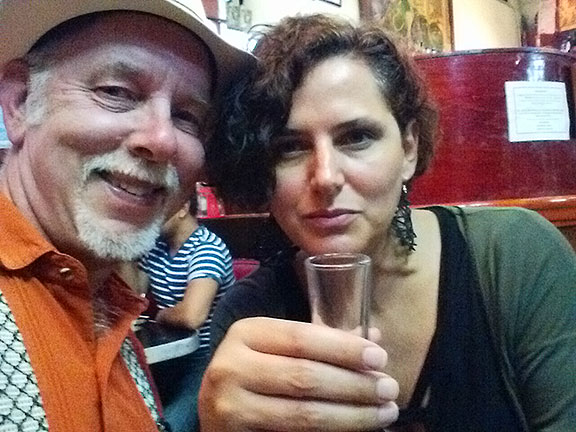
Salud!












Those photos of canals were in the Futuro CDMX exhibit, which had some pretty cool “interactive” exhibits on the 4th floor. No social history but lots of historic maps and fotos.
Great read Chris! I miss the place already. Where were those photos of the canals?